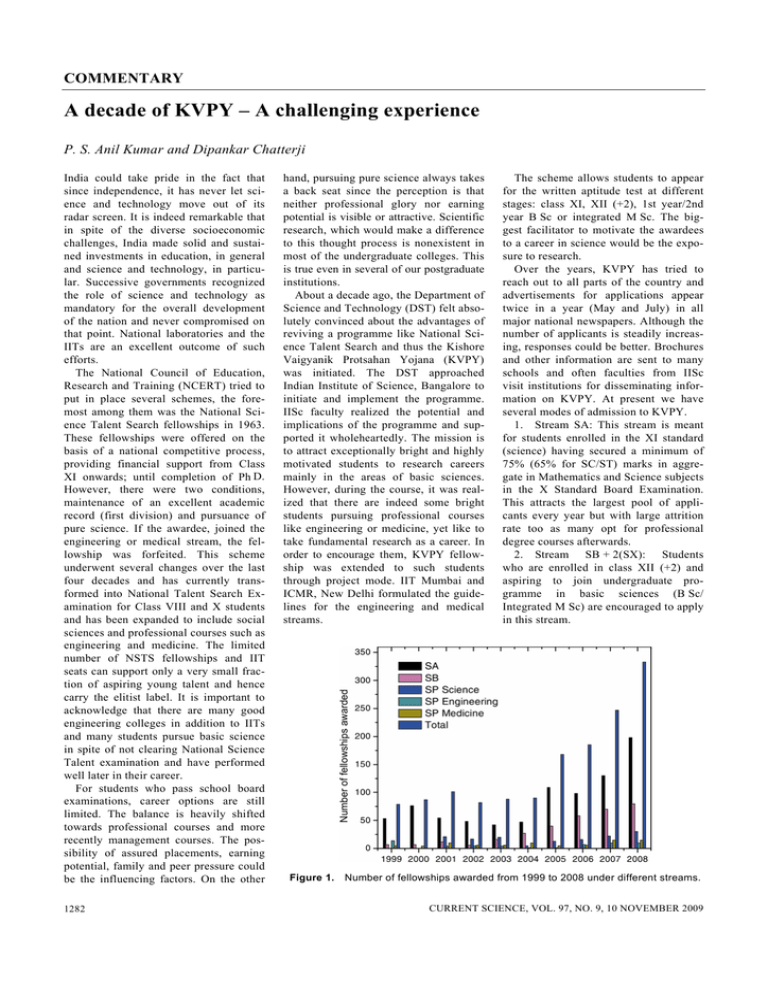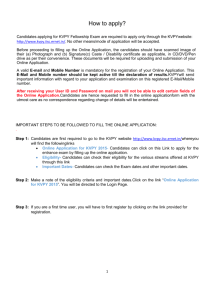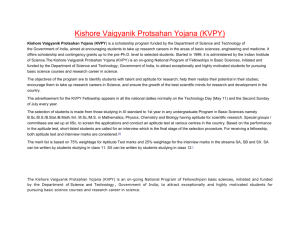A decade of KVPY – A challenging experience COMMENTARY
advertisement

COMMENTARY A decade of KVPY – A challenging experience P. S. Anil Kumar and Dipankar Chatterji India could take pride in the fact that since independence, it has never let science and technology move out of its radar screen. It is indeed remarkable that in spite of the diverse socioeconomic challenges, India made solid and sustained investments in education, in general and science and technology, in particular. Successive governments recognized the role of science and technology as mandatory for the overall development of the nation and never compromised on that point. National laboratories and the IITs are an excellent outcome of such efforts. The National Council of Education, Research and Training (NCERT) tried to put in place several schemes, the foremost among them was the National Science Talent Search fellowships in 1963. These fellowships were offered on the basis of a national competitive process, providing financial support from Class XI onwards; until completion of Ph D. However, there were two conditions, maintenance of an excellent academic record (first division) and pursuance of pure science. If the awardee, joined the engineering or medical stream, the fellowship was forfeited. This scheme underwent several changes over the last four decades and has currently transformed into National Talent Search Examination for Class VIII and X students and has been expanded to include social sciences and professional courses such as engineering and medicine. The limited number of NSTS fellowships and IIT seats can support only a very small fraction of aspiring young talent and hence carry the elitist label. It is important to acknowledge that there are many good engineering colleges in addition to IITs and many students pursue basic science in spite of not clearing National Science Talent examination and have performed well later in their career. For students who pass school board examinations, career options are still limited. The balance is heavily shifted towards professional courses and more recently management courses. The possibility of assured placements, earning potential, family and peer pressure could be the influencing factors. On the other 1282 hand, pursuing pure science always takes a back seat since the perception is that neither professional glory nor earning potential is visible or attractive. Scientific research, which would make a difference to this thought process is nonexistent in most of the undergraduate colleges. This is true even in several of our postgraduate institutions. About a decade ago, the Department of Science and Technology (DST) felt absolutely convinced about the advantages of reviving a programme like National Science Talent Search and thus the Kishore Vaigyanik Protsahan Yojana (KVPY) was initiated. The DST approached Indian Institute of Science, Bangalore to initiate and implement the programme. IISc faculty realized the potential and implications of the programme and supported it wholeheartedly. The mission is to attract exceptionally bright and highly motivated students to research careers mainly in the areas of basic sciences. However, during the course, it was realized that there are indeed some bright students pursuing professional courses like engineering or medicine, yet like to take fundamental research as a career. In order to encourage them, KVPY fellowship was extended to such students through project mode. IIT Mumbai and ICMR, New Delhi formulated the guidelines for the engineering and medical streams. Figure 1. The scheme allows students to appear for the written aptitude test at different stages: class XI, XII (+2), 1st year/2nd year B Sc or integrated M Sc. The biggest facilitator to motivate the awardees to a career in science would be the exposure to research. Over the years, KVPY has tried to reach out to all parts of the country and advertisements for applications appear twice in a year (May and July) in all major national newspapers. Although the number of applicants is steadily increasing, responses could be better. Brochures and other information are sent to many schools and often faculties from IISc visit institutions for disseminating information on KVPY. At present we have several modes of admission to KVPY. 1. Stream SA: This stream is meant for students enrolled in the XI standard (science) having secured a minimum of 75% (65% for SC/ST) marks in aggregate in Mathematics and Science subjects in the X Standard Board Examination. This attracts the largest pool of applicants every year but with large attrition rate too as many opt for professional degree courses afterwards. 2. Stream SB + 2(SX): Students who are enrolled in class XII (+2) and aspiring to join undergraduate programme in basic sciences (B Sc/ Integrated M Sc) are encouraged to apply in this stream. Number of fellowships awarded from 1999 to 2008 under different streams. CURRENT SCIENCE, VOL. 97, NO. 9, 10 NOVEMBER 2009 COMMENTARY 3. Stream SB: Students enrolled in 1st year B Sc/Integrated M Sc apply for this programme. It is our experience that this group of students usually continues with research activity and pursues science. 4. Stream SP (basic sciences): This programme is meant for students enrolled in XI/XII standard, I/II year (B Sc/ Integrated M Sc) in basic sciences. An original and creative science-based research project is compulsory. Figure 2. KVPY scholarships are designed to foster scientific curiosity in the minds of students and the discrimination among science, engineering or medicine streams is not intended. Of course, awards in SA stream are discontinued once students opt for professional degrees. On the other hand, KVPY opened up fellowships for engineering and medical students who can design an original science-based research project. These are called SP streams and managed by IIT, Mumbai and ICMR, Delhi. We noticed that SP programme serves a very important cause. This is the mechanism to spot and support students who have an original and creative mind and can think out of the box but not adequately equipped for competitive examination and/or with poor language skills. They could submit an innovative project and defend it during the interview. Number of fellowships awarded from 1999 to 2008. CURRENT SCIENCE, VOL. 97, NO. 9, 10 NOVEMBER 2009 1283 COMMENTARY Figure 1 shows the number of fellowships awarded during the period 1999– 2008 for different streams such as SA, SB and SP. In the first few years, the number of fellowships was less than 100 per year. Realization of the success and impact of the KVPY programme has led to a substantial increase in fellowships from 2005 onwards. In 2005, more than 150 fellowships were offered and the number has reached 333 in 2008. Maximum fellowships are given in the SA stream followed by SB. The project mode in basic science was started in 2001 and in 2008, 30 fellowships were offered in this stream. KVPY scholars have several advantages besides the fellowships they get from DST. They have the option to join the summer programme in any national research institution. They have access to libraries and science museums throughout the country and can seek out mentors. Within this 10year period, a degree of prestige is increasingly being associated with KVPY fellows, which is very reassuring. In addition, there is a mentoring programme where students are encouraged to take up summer projects at prestigious institutes. These students are recommended by the interview boards of medicine and engineering streams. They get a consolidated amount during summer to carry out their research projects in different research institutions. In Figure 2 a, we have the gender demography for the period 1999–2008 in the SA stream. It can be seen that the number of female fellowship holders is less than 20% of the total fellowships. It is interesting to note that the number of female candidates appearing for the aptitude test is also of the order of 20%. Hence, female students need to be encouraged to appear for the aptitude test. How can this issue be addressed? Can different school boards give some lead in this regard? Figure 2 b shows similar data for the SB stream. Here again the percentage of female candidates is less than 20 of the total fellowships. SP basic sciences register similar trends (Figure 2 c). In case of SP engineering (Figure 2 d) female fellowship holders are far less in number. This trend is repeated in SP medical as well (Figure 2 e). It is conspicuous that the total number of female fellowship holders is very low. We need to put in special efforts to encourage female students to appear for the aptitude test. As a first step, the KVPY is increas1284 Figure 3. centres. Number of students who applied for the KVPY 2008 aptitude test at different ing the number of examination centres in the country. It is expected that the proximity of examination centres will enhance the number of candidates in general and motivate female students specifically. In Figure 3, the break-up of the number of students who applied for the aptitude test at different centres for the KVPY 2008 is given. Delhi tops the list. In 2009, six more centres were added to the existing sixteen. It can be seen that maximum number of students apply for the SA stream followed by SB + 2 and SB. It has been realized that the number of SB candidates applying for the KVPY aptitude test is very less. A special drive needs to be initiated to enhance the awareness among the B Sc students towards the KVPY programme. In the SB stream, Kolkata centre is marginally ahead of the Delhi centre. We have also made an analysis about the performance of the students in the KVPY aptitude test. We have analysed the data based on the results of the KVPY–SA aptitude test conducted in November 2008. Here, at first we have calculated the average mark obtained in the KVPY test for the Mathematics, Physics, Chemistry and Biology by the students from a particular board where they have passed the X standard examination. Then this analysis is done for all the boards. Subsequently, the average mark for a subject is normalized with the average mark of the students of a board which has obtained the highest average mark. For example, in Mathematics the students from the Andhra Pradesh state board obtained the highest average mark in the KVPY aptitude test, hence the average mark of the students in KVPY aptitude test from all other boards is normalized with respect to the mark from the Andhra Pradesh Board. The national average has also been included for comparison. Only five boards are above this national average. We have not included the data from several other state boards as the number of students appearing from those boards are too few. In Figure 4 b, we give the same data for physics. ICSE tops the list followed by Andhra Pradesh and West Bengal State Boards. In the case of chemistry (Figure 4 c), ICSE tops the list followed by CBSE and West Bengal State Board. In case of biology (Figure 4 d) the ICSE board tops the list followed by West Bengal State Board. It is interesting to note that in chemistry and biology, the performance across central and state boards is more or less uniform but in mathematics and physics, the disparity is huge. These statistics should help us in identifying and rectifying the gap in these two subjects. CURRENT SCIENCE, VOL. 97, NO. 9, 10 NOVEMBER 2009 COMMENTARY Figure 4. Performance of students from various central and state boards in the aptitude test for SA stream. The average mark obtained by the students in each board has been normalized by the average mark from the board which has the highest average mark. Figure 5. Expenditure (in rupees) for KVPY during (a) 1999–2008 and (b) 2008–09. The cost factor Figure 5 a depicts the break-up of the KVPY expenditure. Major overheads (52.3%) are for fellowships and contingency grants to students followed by the operating cost of 39.56%. Operating cost includes advertisement, expenses of con- CURRENT SCIENCE, VOL. 97, NO. 9, 10 NOVEMBER 2009 ducting the aptitude test and interviews, printing of posters, brochures, etc. Summer programmes constitute an integral part of the KVPY fellowship and 1285 COMMENTARY cost 3.35% of the total budget. KVPY fellows are invited to premier research institutes in the country and exposed to various aspects of research and training. Lectures by eminent scientists and academicians, hands-on training at laboratories, laboratory visits, etc. are also organized. This is the first step towards mentoring the students to a research career. Over the years, the overall operating cost has gradually and systematically reduced and in 2008–09, it was at a low of 23.59% (Figure 5 b). Conclusion In course of the article, the following trends emerge: • Number of applicants is increasing every year, though mostly from the urban areas. This calls for urgent attention keeping in mind that the examination is conducted only in English language. 1286 • We have been successful so far in not publicizing the questions. The students have to return the question paper after the examination. This has helped us to build a rich question bank by adding new questions each year. Also, this has discouraged the setting up of coaching centres for KVPY. • There is a large intake at the SA level, but on the flipside, there is also a large attrition rate. Undoubtedly these students are joining IIT or other professional degree courses. The SX is a fairly new programme and no analysis can be done from the data, although it appears that there is attrition! • Most often students from SB and SP (science) stream pursue research careers. At the national level, even if 100 KVPY beneficiaries opt for scientific research every year, it is a great step forward. • Currently, altogether 100 KVPY fellows have either completed Ph D or are pursuing Ph D. The establishment of five IISERs by the Govt of India is a tremendous boost for undergraduate teaching and research programmes. They can accommodate all the successful KVPY scholars along with their regular students. Then we have the IITs’ integrated programmes and undergraduate programmes in Hyderabad University and in many other centres. The recent initiative of DST, the INSPIRE programme has a larger canvas. We are certain that many other similar programmes will be initiated to provide an opportunity for bright students to pursue scientific research. P. S. Anil Kumar is in the Department of Physics, Indian Institute of Science, Bangalore 560 012, India; Dipankar Chatterji* is in the Molecular Biophysics Unit, Indian Institute of Science, Bangalore 560 012, India. *e-mail: dipankar@mbu.iisc.ernet.in CURRENT SCIENCE, VOL. 97, NO. 9, 10 NOVEMBER 2009




